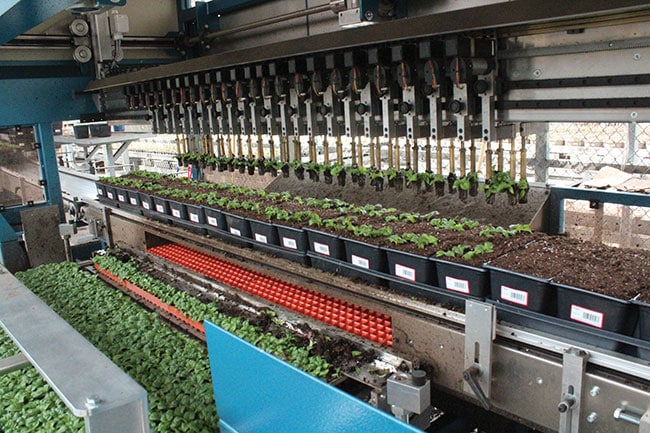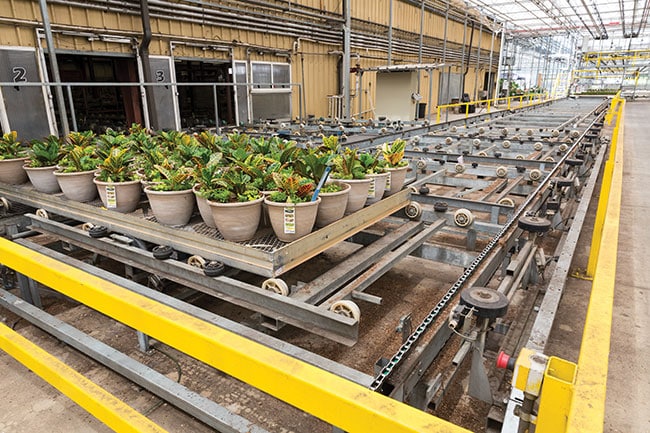
Investing in Innovation at Metrolina Greenhouses
Starting out building a new facility, it all comes down to what you’re planning to grow and your operation’s long-term goals. A vegetable farmer might look at building a greenhouse in a totally different way than a cannabis farmer does, and a grower producing plugs will have completely different ideas from a finished plant grower. It really depends on the crop that will grow in the greenhouse, and then picking the right greenhouse for the crop.
From there, determine what kind of efficiencies you need and where you want to take the bulk of the work out of production. The key to the growth of our business at Metrolina Greenhouses is continuing to invest in innovation. We try to take all the repetitive work out of production that we possibly can. From environmental controls to robotic transplanters and irrigation to table movers, we use automated processes throughout our facilities to improve efficiency and ensure our team has the tools they need to make their work productive and enjoyable.
There’s no one right answer for every greenhouse, but there is a right answer for your greenhouse — that’s just what you have to figure out.
PLANNING FOR CONSTRUCTION AND EXPANSION
Building efficiently is complicated, so you need a plan. That includes considering local tax rates and securing regional and local zoning laws when selecting a location. Most greenhouses are built in rural areas, so permitting is easier, but growers need to consider whether the site offers ample water, electricity, gas and other utilities. Many greenhouse owners have found out the hard way that remote farmland can be less expensive, but digging wells and acquiring basic utilities adds to the cost of setting up an enterprise on that land. Then there’s labor — the more remote the business, the harder it can be to find enough reliable labor locally.
It is crucial to design your greenhouse facility with an eye to the future, considering the size of the greenhouse operation and future expansion prior to building. One of the bigger mistakes growers make while designing a greenhouse or range is thinking too small. This goes for the layout of the facility, as well as designing utility infrastructure, as lead times for utilities can sometimes take months or even years when building or expanding a facility. Consider asking your engineer to prepare designs for the initial build out and future expansion up front to save time and trouble down the road.
It’s important to build as close to the front of your property as you can, so your production barn and shipping barn are in the front, and the greenhouses are behind them. You need to know if the facility can accommodate future growth before you have a need or desire to expand. I’ve helped fellow greenhouse owners think this out. They send me a map of their land and I’ll give them 20 phases of greenhouse buildout plans. You may never get to that size and that’s okay as long as you look ahead. Visualize the next year, five years, 10 years and 20 years down the road, and what you want your business to look like.

CONSTRUCTING EFFICIENT GREENHOUSES
Designing and building a new greenhouse facility will require additional capital when you hire an architect and construction team; however, growers who don’t have a lot of experience in building greenhouses should hire a contractor who knows what they’re doing. Facility owners, managers and head growers should be involved in the planning and design to ensure the build aligns with the production strategy and goals, but ultimately the construction should be completed by experts.
Fifty years ago, everyone built their greenhouses running north to south but, from our experience, the optimal way to build a greenhouse is 45 degrees to the east and west. That way, the sun is always going across at an angle, so your shade is always moving across at an angle, and everything gets sun at some point. There are seemingly endless choices in greenhouse styles and manufacturers, so the type of greenhouse you build really depends on the crop you want to grow and what you deem important in production. Ventilation, for example, is a key consideration. If you plan to build closed-roof greenhouses, you’ll need pad-and-fan ventilation, but that type of system is typically limited to 300 feet.
We build 1,500-foot-long greenhouses, and we choose to build open-roof because we want good air movement. The more we can move that air, the better for the health and quality of the plants. But not all open-roof structures are created equal. If one greenhouse roof is open 3 feet and the next two are closed, that is not equal to opening every greenhouse 1 foot because, in my mind, there are always two greenhouses that are closed. Air is never getting out of that top 20%, so I would rather be able to crack every roof. You run a more efficient greenhouse when you can do that.
AUTOMATING FOR EFFICIENCY
These days, a grower should expect to invest $25 to $30 per square foot in their greenhouse facility; the days of $10 per square foot are over if you want to include anything more than just the structure itself. Much like the type of greenhouse structure needed to efficiently produce the best crop, the investments in automation will vary depending upon what makes sense for the crop you want to grow.
There are some turnkey efficiencies that could work across multiple crops, including environmental controls, heating, irrigation, ventilation, lighting and blackout curtains. For example, greenhouse vegetables, cannabis and ornamentals — like mums and poinsettias — need light deprivation and supplemental lighting at some point in production, so investments in blackout curtains and lighting are essential, whereas ornamentals producers won’t need them unless they’re producing young plants.
In addition to saving time and labor, automation also reduces input costs and offers more opportunities to be environmentally sustainable. When investing in lighting, look at all your options, from HIDs to LEDs, to determine longevity and short- and long-term benefits. There is a great deal of research available on the different light spectrums and how the colors aid in growing higher-quality crops. Further, LEDs may offer better energy efficiency overall, while traditional lighting such as HID or HPS puts out heat along with light, which can be helpful in colder climates.
Selecting the right irrigation based on the crop you’re producing can significantly reduce the amount of water and nutrients used, but it may require deep investments in equipment and infrastructure at the start. Growers producing propagation material can benefit from a boom for misting and light watering. As the plant grows, you’ll want to incorporate sprinklers, drip irrigation or even flood floors. We like flooding at our operation in Huntersville, North Carolina, because it gets the water to the roots. At our facility in York, South Carolina, we use drip tape, which allows us to get the water right to the plant. We use 80% less water in our mums today than we did five years ago, when we were just overhead watering, and we’re saving 70% on feed because we are putting the feed into the plant where it belongs, which has reduced runoff.
It’s easy to get carried away with the new automation technology coming into the market. Ultimately, the right investments depend on the crop you’re growing, how you plan to implement the technology for that crop, and the resulting efficiencies that will quickly produce a return on your investment.
All growers want the newest toys, but the key is to be a smart businessperson. Know how much money you can invest and how much revenue you can bring in, and make sure you can make those numbers jive with each other.
For an enhanced reading experience, view this article in our digital edition by clicking here.








 Video Library
Video Library 

















